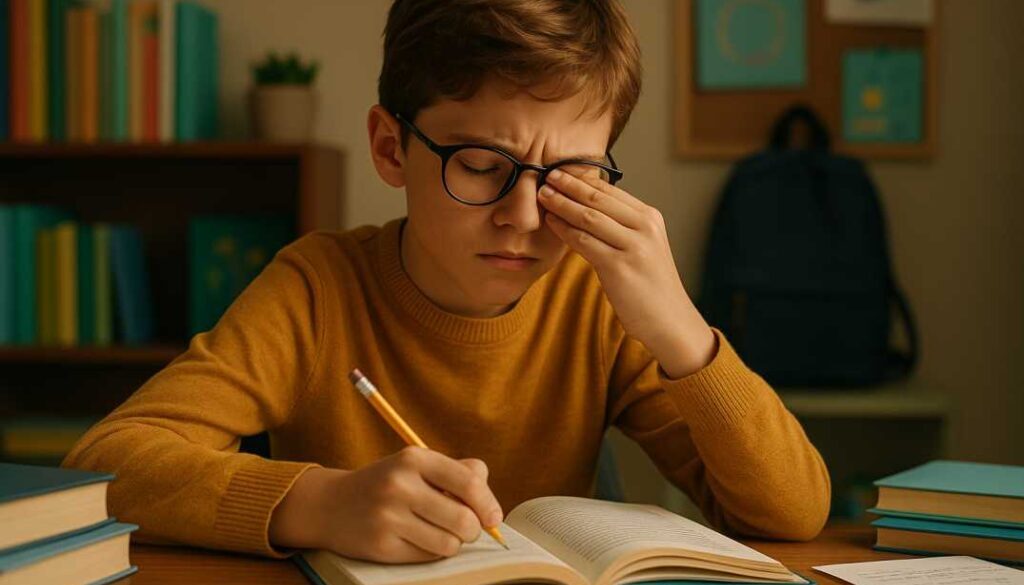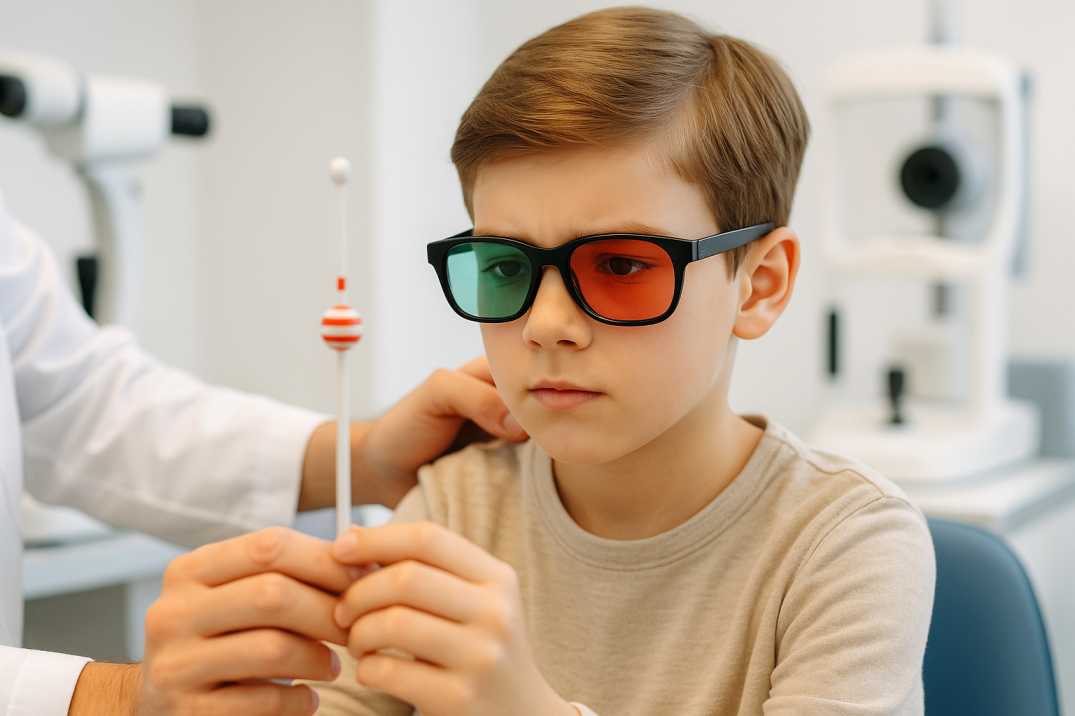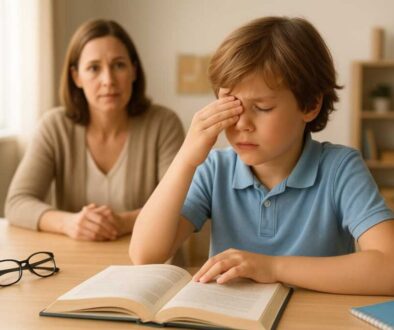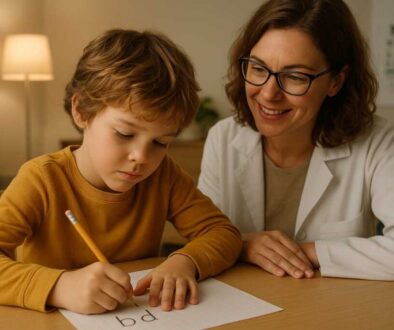Vision Therapy for Gifted Students Who Struggle

When your intellectually gifted child struggles academically despite their obvious intelligence, the frustration can be overwhelming. You’ve tried tutoring, changed study methods, and consulted with teachers, yet something still holds them back. The missing piece might surprise you: undiagnosed vision problems that traditional eye exams never detect.
Gifted students frequently experience vision difficulties that interfere with their ability to perform at their true potential, often going unrecognized because their high intelligence allows them to compensate. Optometrists’ Vision Therapy. These aren’t issues with seeing clearly at 20 feet—they’re functional vision problems that affect how the eyes and brain work together during reading, writing, and learning.
The Hidden Struggle: Why Gifted Students Are Overlooked
Many gifted children are developmentally advanced verbally but struggle significantly with visually presented materials in school, creating frustration because they perform at a high enough level to not qualify for help despite having a huge discrepancy in performance compared to some of their other abilities. Surprise, Surprise: Vision Problems of Gifted Children (Part 1).
This paradox creates a unique challenge. Your child might:
- Excel in oral discussions but struggle to complete written work
- Understand complex concepts immediately, but take forever on homework
- Score well on tests yet avoid reading whenever possible
- Display remarkable intelligence in some areas while appearing careless or lazy in others
Gifted children with eye-muscle coordination problems compensate by learning to skim material, leaving out or misreading words, but using intelligence to make sense of what they’ve read. Gifted Students – Cook Vision Therapy. This compensation masks the underlying issue, allowing vision problems to go undetected for years.
The Cost of Overlooking Vision Problems:
When vision issues go unaddressed in gifted children, the consequences extend beyond academics. These students often develop anxiety, perfectionism, and self-doubt as they struggle to understand why they can’t perform at the level they know they’re capable of achieving. Early identification and intervention can prevent years of unnecessary struggle.
Common Vision Problems Affecting Gifted Students
Convergence Insufficiency: The Most Common Culprit
The prevalence of convergence insufficiency in school-age children ranges from 2% to 13%, with the most common figure cited in literature around 5% Convergence Insufficiency – StatPearls – NCBI Bookshelf. When reading or doing close work, both eyes must aim precisely at the same point. With convergence insufficiency, this coordination fails, causing:
- Double vision or blurred text
- Words appearing to move on the page
- Headaches and eye strain during reading
- Difficulty concentrating on schoolwork
- Frequent loss of place while reading
With convergence insufficiency, the eyes have trouble pointing inward to focus on something close, and one eye may turn out instead of looking inward, causing blurred vision, double vision, and eyestrain. Convergence Insufficiency (Child) | Saint Luke’s Health System.
Why It’s Often Missed: Standard eye exams test distance vision at 20 feet. A child can have perfect 20/20 vision and still have severe convergence insufficiency that makes reading agonizing.
Poor Eye Tracking and Teaming
Gifted students need superior visual skills to match their cognitive abilities. When eye movement control lags behind intellectual capacity, reading becomes laborious. The eyes may:
- Skip words or entire lines
- Re-read the same sentence repeatedly
- Move inefficiently across the page
- Fail to work together as a coordinated team
These inefficient eye movements force the brain to work overtime to make sense of jumbled visual information, leading to mental fatigue and reduced comprehension despite high intelligence.
Visual-Motor Integration Challenges
Some gifted children have excellent reading skills but struggle with handwriting—their writing is slow and difficult, with variable sizing and spacing of letters, leading them to avoid writing despite having wonderful ideas. Chicago Gifted Community Center – Articles. When your mind travels at a hundred miles per hour while your hands are lucky to make the speed limit, getting thoughts on the page becomes a chore. Gifted Students – Cook Vision Therapy.
This disconnect between cognitive processing speed and visual-motor output creates immense frustration. Teachers may incorrectly assume the child is lazy or unmotivated when the real issue is a treatable vision problem.
The Visual-Spatial Learning Connection
Research shows that at least one-third of the student body is strongly visual-spatial, with 60 percent of children in a regular classroom preferring a visual-spatial learning style. Visual-Spatial Learners — Gifted Development Center. These gifted visual-spatial learners often face unique challenges:
- They think in pictures rather than words
- They grasp concepts all at once (“Aha!”) rather than step-by-step
- They struggle with sequential tasks and showing their work
- They see relationships and patterns that others miss
- They excel with complex material but struggle with simple, repetitive tasks
Children with higher intelligence need much higher-than-average visual processing skills to actualize their gifts, analogous to super athletes who have extraordinarily higher-than-average visual skills to support high-level performance demands. The Gift of Vision for the Gifted — Gifted Development Center.
The Mismatch Problem: Most traditional education is designed for auditory-sequential learners who process information step-by-step. Visual-spatial gifted learners with vision problems face a double challenge: their learning style doesn’t match the teaching method, AND their visual system isn’t functioning optimally.
Red Flags: Signs Your Gifted Child May Have Vision Problems
Watch for these warning signs that indicate a comprehensive vision evaluation may be needed:
Reading and Learning Behaviors
- Avoids reading or completes it reluctantly
- Uses finger to track while reading
- Loses place frequently
- Reads slowly despite high comprehension
- Complaints that words blur or move
- Covers or closes one eye when reading
Physical Symptoms
- Headaches, especially after schoolwork
- Eye rubbing or excessive blinking
- Complaints of tired, burning, or itchy eyes
- Tilts head or positions body awkwardly when reading
Academic Performance
- High verbal scores but lower performance scores on IQ tests
- The gap between potential and actual achievement
- Inconsistent academic performance
- Better at explaining concepts orally than in writing
- Difficulty completing timed tests despite knowing the material
Behavioral Indicators
- Frustration with homework
- Says “I can’t” before trying challenging visual tasks
- Avoids puzzles, crafts, or detailed work
- Poor handwriting despite adequate fine motor skills
- Difficulty copying from the board
Important Note: Even one or two of these symptoms warrant a comprehensive functional vision evaluation. Don’t wait for multiple symptoms to appear—early intervention produces the best results.
How Vision Therapy Helps Gifted Students
Vision therapy is a customized program of visual activities designed to correct specific vision problems and improve visual skills. Unlike glasses that simply focus images more clearly, vision therapy teaches the visual system to perform more efficiently.
The Science Behind Vision Therapy
Studies demonstrate that vision therapy is an effective treatment option for convergence insufficiency in children, with office-based therapy being more effective than home-based therapy. 2017 Glenn A. Fry Award Lecture: Establishing an Evidence-based Literature for Vision Therapy – A 25 Year Journey – PMC. Research shows that 75 percent of children who had weekly office-based vision therapy coupled with 15 minutes of at-home exercise five days a week experienced significant improvement in their convergence in 12 weeks. Vision Therapy: Evidence-Based Research – Optometrists.org.
The National Eye Institute funded multiple randomized clinical trials proving vision therapy’s effectiveness. These studies also demonstrated that home-based pencil pushups commonly used by both optometrists and ophthalmologists are no more effective than placebo therapy. 2017 Glenn A. Fry Award Lecture: Establishing an Evidence-based Literature for Vision Therapy – A 25 Year Journey – PMC—professional, supervised vision therapy is essential for lasting results.
Evidence-Based Medicine: Vision therapy for convergence insufficiency has Level 1 evidence—the highest quality of clinical research—supporting its effectiveness. This places it among the most rigorously studied treatments in optometry.
What Vision Therapy Addresses
A comprehensive vision therapy program improves:
- Eye teaming: Training both eyes to work together efficiently
- Eye tracking: Developing smooth, accurate eye movements
- Eye focusing: Building flexibility to shift focus quickly between distances
- Visual processing: Enhancing the brain’s ability to interpret visual information
- Visual-motor integration: Coordinating vision with hand movements
- Visual memory: Strengthening the ability to remember what was seen
Think of vision therapy as physical therapy for your eyes and brain. Just as physical therapy strengthens muscles and improves coordination after an injury, vision therapy trains the visual system to function more effectively.
Expected Outcomes for Gifted Students
The impact of vision therapy may include improvements in reading, writing, sports, processing speed, behavior, and confidence, with IQ scores in follow-up testing often showing improvement.t The Gift of Vision for the Gifted — Gifted Development Center.
Real results from gifted students who completed vision therapy:
- A student became an A-plus student, reading almost two grade levels above her age level, with increased self-esteem and self-confidence, less than a year after she couldn’t read at all. Vision Therapy for Gifted Learning Difficulty (GLD): Success Stories – Optometrists.org
- A fourth grader’s reading ability jumped from first-grade level to college level. The Gift of Vision for the Gifted — Gifted Development Center.
- After a year of vision therapy treatment, a student showed tremendous improvement in all visual areas, was no longer symptomatic, made great strides in academics, and had greatly enhanced self-esteem. Chicago Gifted Community Center – Articles.
These aren’t isolated success stories—they represent the typical outcomes when vision problems are properly diagnosed and treated in gifted children.
The Vision Therapy Process: What to Expect
Comprehensive Evaluation
Unlike standard eye exams that only check if you can see clearly at 20 feet, a functional vision examination evaluates 17 different visual skills essential for learning:
- Near point of convergence
- Positive and negative fusional vergence
- Accommodative facility and amplitude
- Eye movement control (saccades and pursuits)
- Visual perception and processing
- Visual-motor integration
- Depth perception and 3D vision
What Makes It Different: A comprehensive functional vision exam typically takes 60-90 minutes, compared to 15-20 minutes for a standard eye exam. The doctor evaluates how well your child’s visual system performs during actual reading and learning tasks.
Customized Treatment Program
Each vision therapy program is individually designed based on the evaluation results. A typical program includes:
- Duration: 12-24 weeks of therapy
- Office visits: Weekly 45-60 minute sessions with a trained vision therapist
- Home exercises: 15 minutes daily, five days per week
- Progress monitoring: Regular reassessment to adjust activities
Treatment Philosophy: Vision therapy is progressive and adaptive. As skills improve, activities become more challenging, ensuring continuous development toward normalized visual function.
Types of Vision Therapy Activities
Vision therapy uses specialized equipment and activities:
- Computer-based programs targeting specific visual skills
- Therapeutic lenses and prisms
- Balance boards and sensory-motor activities
- Near-far focusing exercises
- Eye teaming and tracking activities
- Visual-spatial perception tasks
These aren’t simple eye exercises—they’re carefully sequenced activities designed to rewire neural pathways and create lasting changes in how the brain and eyes work together.
Why Gifted Students May Resist Treatment
One might think that a vision therapy program would be easier and faster with very smart children, but the opposite is usually the case—gifted students can be resistant to treatment. Surprise, Surprise: Vision Problems of Gifted Children (Part 1). A teenage patient was significantly farsighted with binocular vision problems, but told the optometrist immediately that she didn’t have any problems with her eyes and was upset about being brought in for testing.
Understanding the Resistance
Gifted children often resist vision therapy because:
- They’ve compensated so well that they don’t recognize the problem
- Admitting to difficulty challenges their identity as “smart”
- The exercises feel elementary or tedious to their advanced intellect
- They’re accustomed to excelling without effort
- They fear the stigma of needing help
Overcoming Resistance: Parents and practitioners must understand this resistance and work patiently through it. Frame vision therapy as “athletic training for the eyes” or “upgrading your visual operating system”—language that appeals to gifted children’s desire for optimization and excellence.
The results—often dramatic—make the effort worthwhile. Most resistant students become enthusiastic advocates once they experience the relief of improved vision.
Finding the Right Vision Therapy Provider
Not all eye care professionals provide vision therapy or are trained to recognize functional vision problems in gifted students. When seeking help:
Look for These Credentials
- Doctor of Optometry (O.D.) specializing in developmental or behavioral optometry
- Fellowship in the College of Optometrists in Vision Development (FCOVD)
- Experience specifically working with gifted and twice-exceptional students
The FCOVD credential is particularly important—it represents hundreds of hours of additional training beyond optometry school and successful completion of rigorous examinations.
Questions to Ask During Your Consultation
- Do you perform comprehensive near-point visual testing?
- Do you offer academically related visual perception tests?
- Do you provide one-on-one, office-based vision therapy?
- Will you coordinate with our child’s school and other specialists?
- What is your experience working with gifted students?
- Can you provide references or success stories from similar cases?
Red Flag: Be cautious of providers who promise quick fixes or guarantee results in just a few weeks. Quality vision therapy requires time and commitment to produce lasting changes.
Vision Therapy vs. Traditional Interventions
Many parents invest significantly in tutoring, educational therapy, and accommodations before discovering vision problems. Understanding how vision therapy differs helps set appropriate expectations:
| Traditional Interventions | Vision Therapy |
|---|---|
| Teaches compensatory strategies | Addresses the root visual cause |
| Focuses on academic content | Improves visual system function |
| Requires ongoing support | Creates lasting change in visual abilities |
| Works around the problem | Solves the underlying problem |
Vision therapy doesn’t replace quality education, but provides the visual foundation needed for learning to occur efficiently.
The Bottom Line: If your child has a vision problem, no amount of tutoring will fix it. You must address the underlying visual dysfunction first; then educational interventions become far more effective.
Cost, Insurance, and Time Investment
Typical Investment (Updated 2025)
- Comprehensive functional vision evaluation: $300-$500
- Vision therapy per session: $125-$250 per session
- Complete program (12-24 weeks, 20-30 sessions): $2,500-$7,500
- Home therapy equipment: $100-$300
Vision therapy sessions cost between $125 and $250 per session, with typical treatment ranging from $1,000 to $9,000 depending on the vision problem and the number of sessions needed. The Vision Therapy Center Family Tree Opto. Based on national averages, vision therapy costs approximately $322 for the initial consultation and $122 per weekly appointment, with most patients needing 20-30 visits, making the average total $2,762-$3,982. Cost of Vision Therapy: Examples from all 50 States – Strabismus Solutions.
Insurance Coverage
- Some vision insurance plans cover a portion of vision therapy
- Medical insurance may cover therapy when vision problems result from medical conditions or injuries
- Coverage varies significantly by provider and plan
- Many practices offer payment plans
Insurance Tips: Call your insurance company before the evaluation and ask specifically about coverage for “orthoptics” or “vision therapy” using CPT codes 92065 and 92066. Get the representative’s name and reference number for your records.
Time Commitment
- Weekly 45-60 minute office visits
- 15 minutes daily home practice
- Total program length: 3-6 months typically
The investment pays dividends when your gifted child can finally perform at their true potential, with improved confidence, reduced frustration, and enhanced academic and personal success.
Cost-Benefit Analysis: Consider the cost of vision therapy against years of tutoring, academic struggles, reduced self-esteem, and limited life opportunities. Most families find vision therapy to be the best investment they’ve ever made in their child’s future.
Supporting Your Gifted Child Through Treatment
Parents play a crucial role in vision therapy success:
Create a Supportive Environment
- Acknowledge your child’s frustration and validate their feelings
- Celebrate small improvements along the way
- Make home practice sessions positive and engaging
- Communicate regularly with the vision therapist
- Share progress with teachers and other support providers
Maintain Consistency
- Prioritize daily home exercises
- Attend all scheduled office visits
- Follow through with recommended activities
- Be patient—changes take time
Success Secret: Consistency is more important than perfection. Five days of 10-minute sessions beat sporadic 30-minute sessions every time.
Adjust Expectations Temporarily
- Reduce homework pressure during intensive therapy periods
- Focus on effort rather than perfection
- Communicate with teachers about your child’s treatment
- Provide extra support during challenging times
Some children experience temporary performance dips as their visual system adjusts. This is normal and typically brief.
The Broader Impact: Beyond Academic Success
When vision problems are addressed, improvements extend far beyond reading and schoolwork:
Social and Emotional Benefits
- Increased self-confidence and self-esteem
- Reduced anxiety about school and performance
- Better peer interactions
- Improved body language and eye contact
- Greater willingness to try new activities
Many parents report that their child’s entire personality seems to blossom once vision problems are resolved.
Athletic and Recreational Improvements
- Better hand-eye coordination
- Improved sports performance
- Enhanced depth perception for ball sports
- Increased enjoyment of physical activities
Children who previously avoided sports often discover newfound athletic abilities once their visual system functions properly.
Life Skills Development
- Better organization and time management
- Improved ability to complete tasks efficiently
- Enhanced problem-solving capabilities
- Greater independence with schoolwork
These executive function improvements often surprise parents—they didn’t realize vision problems were affecting so many areas of their child’s life.
Take Action: Next Steps for Your Gifted Child
If your gifted child shows signs of vision problems, here’s your action plan:
Step 1: Schedule a Comprehensive Evaluation
Find a developmental optometrist who has experience with gifted students and schedule a functional vision examination. Don’t delay—early intervention produces the best results.
Step 2: Gather Relevant Information
Collect IQ test results, academic assessments, and teacher observations. This information helps the doctor understand your child’s full profile and tailor the evaluation accordingly.
Step 3: Rule Out Vision Problems First
Before pursuing other interventions or accepting diagnoses like ADHD or dyslexia, rule out vision problems. Many children are misdiagnosed when vision is the underlying issue.
Step 4: Commit to the Treatment Program
If vision therapy is recommended, commit fully to the process. Consistency and follow-through are essential for success.
Step 5: Stay Involved and Engaged
Maintain regular communication with the vision therapist, celebrate progress, and adjust expectations as needed throughout the therapy process.
Take the First Step Today: Contact a qualified developmental optometrist in your area and schedule a comprehensive functional vision evaluation. Your child’s potential is waiting to be unlocked.
Research Resources and Scientific Citations
This article is supported by extensive research from peer-reviewed journals, clinical studies, and expert organizations in developmental optometry and gifted education:
1. National Eye Institute (NEI) – Convergence Insufficiency Treatment Trial
The NEI funded landmark randomized clinical trials demonstrating that office-based vision therapy with home reinforcement is the most effective treatment for convergence insufficiency. The Convergence Insufficiency Treatment Trial (CITT) Study Group published findings in Archives of Ophthalmology (2005, 2008) showing that 75% of children achieved significant improvement within 12 weeks of supervised vision therapy.
Key Finding: Home-based pencil pushups alone are no more effective than placebo therapy, establishing the importance of professional, supervised vision therapy programs.
Research Link: https://www.ncbi.nlm.nih.gov/pmc/articles/PMC6078795/
2. Gifted Development Center – Dr. Linda Silverman’s Research on Visual-Spatial Learners
Dr. Linda Silverman’s extensive research at the Gifted Development Center in Denver, Colorado, has identified that approximately half of the 6,500+ gifted children assessed show patterns on IQ and achievement tests suggestive of visual processing issues. Her work established the connection between giftedness, visual-spatial learning styles, and the need for developmental vision care.
Key Finding: Children with higher intelligence need much higher-than-average visual processing skills to actualize their gifts, and vision therapy can result in IQ score improvements in follow-up testing.
Research Link: https://gifteddevelopment.org/musings/insideout-jjdlj
3. StatPearls – Convergence Insufficiency Clinical Reference (2023)
Published by the National Center for Biotechnology Information (NCBI), this comprehensive clinical reference establishes that convergence insufficiency affects 2-13% of school-age children (most commonly cited as 5%). The resource provides evidence-based diagnostic criteria and treatment protocols, confirming that office-based vergence therapy is considered first-line treatment for symptomatic CI in children.
Key Finding: Convergence insufficiency is a highly treatable binocular vision disorder that can be effectively addressed through structured vision therapy programs, preventing progression to more serious conditions like amblyopia or strabismus.
Research Link: https://www.ncbi.nlm.nih.gov/books/NBK554390/
Conclusion: Unleashing Your Gifted Child’s True Potential
The goal of vision therapy for the gifted person should go beyond remediation of vision deficits—it should be enhanced visual abilities. The Gift of Vision for the Gifted — Gifted Development Center. Your intellectually gifted child deserves visual abilities that match their cognitive potential.
Vision problems create invisible barriers that prevent gifted students from achieving at their true level. These students know they’re capable of more, feel the frustration of underperformance, and often internalize negative messages about their abilities or character. Vision therapy removes these barriers, allowing natural gifts to shine through.
The journey from struggle to success begins with recognition that vision problems can affect anyone, including and especially gifted students whose high intelligence has allowed them to compensate. When parents, educators, and eye care professionals work together, gifted students receive the comprehensive support they need to excel.
Your child’s brilliant mind deserves excellent vision to match. Don’t let undiagnosed vision problems rob your gifted child of their potential. A comprehensive vision evaluation is the first step toward understanding whether vision therapy could unlock the success you know your child is capable of achieving.
The transformation that vision therapy can bring to a struggling gifted child’s life is profound—not just academically, but emotionally, socially, and developmentally. Take action today and give your child the gift of clear, comfortable, efficient vision.
FAQs
-
Vision therapy is a personalized program to improve visual skills like eye tracking and coordination, helping gifted students overcome visual challenges that affect learning and focus.



